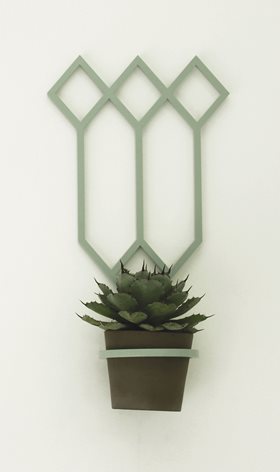.aspx) Poetics of the everyday
Poetics of the everyday
Jessie Mitchell by Gemma Weston
Jessie Mitchell is something of a contemporary polymath. Her practice is multi-disciplinary, transgressing even the ‘traditional’ boundaries that such a label might suggest. Jessie produces work not only in a variety of mediums – textiles, sculpture, drawing and print – but also incorporates the languages and methods of graphic and product design. Her objects display interactions between hand-making and mass production along with a lively use of pattern and motif, sourced from a variety of ‘extracurricular’ activities – gardening, cooking, attending swap meets and community markets. Most recently, Jessie completed a studio residency at Perth Institute of Contemporary Arts (PICA), in which she both deconstructed her processes of research and practice, and translated motifs collected from neighbourhood front yards – the patterns of ironwork, slate and succulent – into a series of poetic sculptures and drawings.
Her background in fashion (she completed her BA in fashion before transferring to an honours in art) is a clear influence as Jessie’s work is often concerned with functionality and tactility, exploring how art practice can become ‘useful’, or can be incorporated into daily or domestic life. Another key influence has been Jessie’s role as an educator in a wide variety of settings including at Kalamunda Senior High’s Gifted and Talented Art Program, in primary schools as part of PICA’s Spark-Lab program and at Curtin University, tutoring as a sessional academic in the textiles department.
Perhaps as a response to the phasing out of textile units from Curtin’s art program, Jessie and collaborator Daniel Bourke presented a series of independent practical workshops in late 2012, a program that the pair plan to develop in 2013 into a focused, three month series of open classes in risograph and textile printing. “It seems a shame that those skills will no longer be taught in that context when there still seems to be such a demand for them,” said Jessie.
 The contrast between different models of learning is evident in her own work, which creates a playful tension between ‘vernacular’ and modernist or classical art and design languages, and in her reflexive approach to teaching. “The workshops that Dan and I ran attracted a really broad skill base. Classes would be a mix of architects, graphic designers, art students, mothers and daughters. And the way each person used their existing knowledge to put together images was so different, which ended up being really beneficial for the group as a whole, as they were able to get a much more varied sense of what the techniques were capable of producing.”
The contrast between different models of learning is evident in her own work, which creates a playful tension between ‘vernacular’ and modernist or classical art and design languages, and in her reflexive approach to teaching. “The workshops that Dan and I ran attracted a really broad skill base. Classes would be a mix of architects, graphic designers, art students, mothers and daughters. And the way each person used their existing knowledge to put together images was so different, which ended up being really beneficial for the group as a whole, as they were able to get a much more varied sense of what the techniques were capable of producing.”
The divisions between art practice and pedagogy have, for Jessie, become increasingly blurred.
Although the outcomes of her work are varied (2012 saw her run a pop-up nail salon specialising in fruit themed manicures, and she is currently planning a collaboration with a friends’ elderly father, whose painstakingly hand-woven rugs Jessie describes as “like nothing else I have seen”) each project examines the production of communities, the interactions and cross pollinations that art practice allows in lived, shared, transmitted experience. “I really enjoy the social aspects of learning and art making – the surprising relationships that form when people come together to share skills. There is something really healthy about that, about keeping those relationships somewhat open and democratic.”
Gemma Weston is a freelance writer, sessional academic and member of Oktachoron, an artistic, curatorial and ‘slow business’ collaborative. Oktachoron (Weston, Jamie Macchiusi and Andrew Varano) currently direct OK Gallery, Northbridge.
This article featured in the Artsource Newsletter, Autumn 2013.